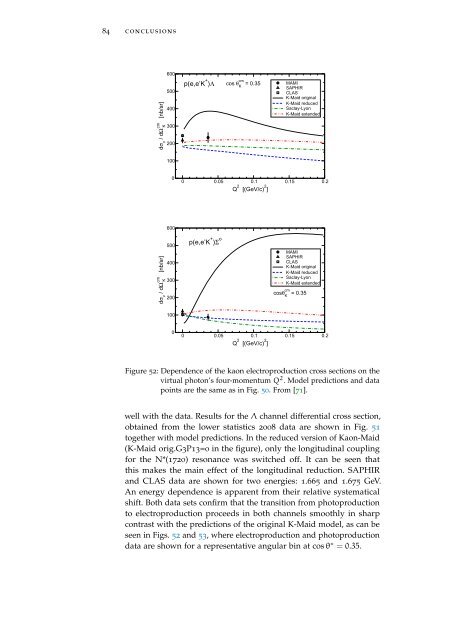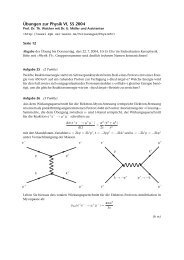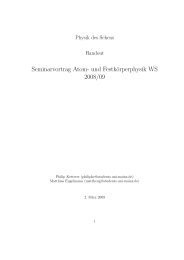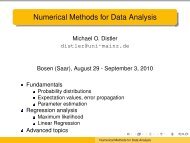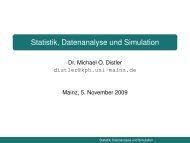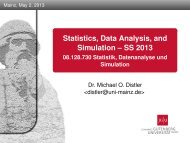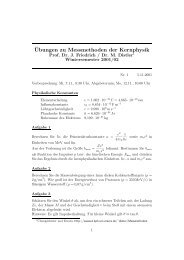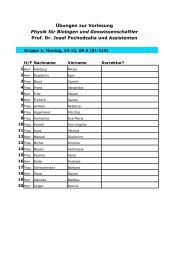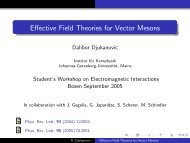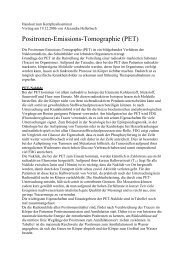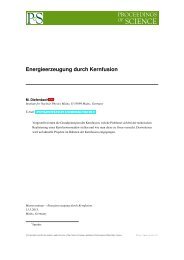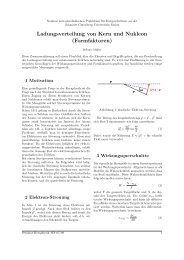A Classic Thesis Style - Johannes Gutenberg-Universität Mainz
A Classic Thesis Style - Johannes Gutenberg-Universität Mainz
A Classic Thesis Style - Johannes Gutenberg-Universität Mainz
You also want an ePaper? Increase the reach of your titles
YUMPU automatically turns print PDFs into web optimized ePapers that Google loves.
84 conclusions<br />
cm [nb/sr]<br />
dσ v / dΩ K<br />
cm [nb/sr]<br />
dσ v / dΩ K<br />
600<br />
500<br />
400<br />
300<br />
200<br />
100<br />
0<br />
600<br />
500<br />
400<br />
300<br />
200<br />
100<br />
0<br />
p(e,e’K + cm<br />
)Λ cos θ = 0.35<br />
K<br />
MAMI<br />
SAPHIR<br />
CLAS<br />
K-Maid original<br />
K-Maid reduced<br />
Saclay-Lyon<br />
K-Maid extended<br />
0 0.05 0.1 0.15 0.2<br />
Q 2 [(GeV/c) 2 ]<br />
p(e,e’K + )Σ o<br />
MAMI<br />
SAPHIR<br />
CLAS<br />
K-Maid original<br />
K-Maid reduced<br />
Saclay-Lyon<br />
K-Maid extended<br />
cm<br />
cosθ = 0.35<br />
K<br />
0 0.05 0.1 0.15 0.2<br />
Q 2 [(GeV/c) 2 ]<br />
Figure 52: Dependence of the kaon electroproduction cross sections on the<br />
virtual photon’s four-momentum Q 2 . Model predictions and data<br />
points are the same as in Fig. 50. From [71].<br />
well with the data. Results for the Λ channel differential cross section,<br />
obtained from the lower statistics 2008 data are shown in Fig. 51<br />
together with model predictions. In the reduced version of Kaon-Maid<br />
(K-Maid orig.G3P13=0 in the figure), only the longitudinal coupling<br />
for the N*(1720) resonance was switched off. It can be seen that<br />
this makes the main effect of the longitudinal reduction. SAPHIR<br />
and CLAS data are shown for two energies: 1.665 and 1.675 GeV.<br />
An energy dependence is apparent from their relative systematical<br />
shift. Both data sets confirm that the transition from photoproduction<br />
to electroproduction proceeds in both channels smoothly in sharp<br />
contrast with the predictions of the original K-Maid model, as can be<br />
seen in Figs. 52 and 53, where electroproduction and photoproduction<br />
data are shown for a representative angular bin at cos θ ∗ = 0.35.


